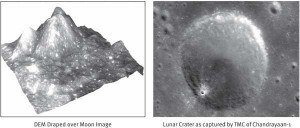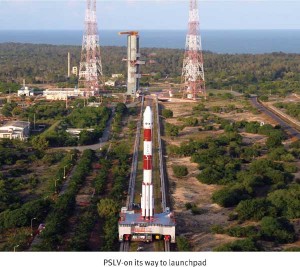ISRO Telemetry, Tracking and Command Network (ISTRAC) had a lead role in establishing the Ground Segment facility of Chandrayaan-1 along with ISAC and SAC. The Ground Segment of Chandrayaan-1 consists of:
- Indian Deep Space Network (IDSN),
- Spacecraft Control Centre (SCC)
- Indian Space Science Data Centre (ISSDC)
 The Indian Deep Space Network performs the important task of receiving the radio signals transmitted by Chandrayaan-1 that are very feeble by the time they reach the Earth. Besides, it can send commands to the spacecraft at a power level of upto 20 kilowatts. IDSN consists of two large parabolic antennas – one 18 m in diameter and the other 32 m in diameter – at Byalalu, situated at a distance of about 35 km from Bangalore. Of these, the 32 m antenna with its ’seven mirror beam waveguide system’ is indigenously designed, developed, built, installed, tested and qualified. The 18 m antenna can support Chandrayaan-1 mission, but the 32 m antenna can support spacecraft missions well beyond the Moon.
The Indian Deep Space Network performs the important task of receiving the radio signals transmitted by Chandrayaan-1 that are very feeble by the time they reach the Earth. Besides, it can send commands to the spacecraft at a power level of upto 20 kilowatts. IDSN consists of two large parabolic antennas – one 18 m in diameter and the other 32 m in diameter – at Byalalu, situated at a distance of about 35 km from Bangalore. Of these, the 32 m antenna with its ’seven mirror beam waveguide system’ is indigenously designed, developed, built, installed, tested and qualified. The 18 m antenna can support Chandrayaan-1 mission, but the 32 m antenna can support spacecraft missions well beyond the Moon.
The Spacecraft Control Centre, located near the ISTRAC campus at Peenya, north of Bangalore, is the focal point of all the operational activities of Chandrayaan-1 during all the phases of the mission.
The Indian Space Science Data Centre forms the third element of Chandrayaan-1 Ground Segment. Also located at Byalalu, ISSDC receives (from IDSN as well as other external stations that support Chandrayaan-1), stores, processes, systematically archives, retrieves and distributes the precious scientific information sent by Chandrayaan-1 payloads.
 Chandrayaan-1 is the most challenging endeavour of ISRO in exploring space.
Chandrayaan-1 is the most challenging endeavour of ISRO in exploring space.
Cost
Cost of Chandrayaan-1 mission is Rs 386 crore and this includes Rs 100 crore for the establishment of Indian Deep Space Network. The DSN facilities meet the requirements of not only Chandrayaan-1 but also future inter planetary missions.
Conclusion
All the payloads have been switched on and are working satisfactorily. Excellent quality imagery of the lunar surface of both nearside and far side have been obtained by Terrain Mapping Camera (TMC) and Hyper-Spectral Imager (HySI) cameras. Chandrayaan-1 has successfully demonstrated the country’s capability and expertise in accomplishing highly complex space missions. The success of Chnadrayaan-1 has paved way for undertaking missions to Moon and beyond.




